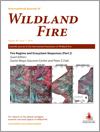International Journal of Wildland Fire
Volume 28
Number 7 2019
Fire Regime and Ecosystem Responses (Part 2)
We present the second part of the special issue that includes six novel studies with information on the wildland–urban interface (WUI) and the restoration of burned areas in the WUI, as well as the post-wildfire ecosystem restoration of burned forests. Landscape management was also investigated using remote sensing techniques and simulation modelling to improve ecosystem resilience.
We analysed wildland–urban interface (WUI) changes and wildfire occurrence in Patagonia, Argentina. Only 6.4% of the study area was considered as WUI, but contained 97% of the houses. Between 1981 and 2016, WUI increased by 76%, and from 2010 to 2015, 77% of the ignition points occurred within this WUI.
An area of 120 ha inside Haifa and along the wildland–urban interface was damaged by fire in November 2016. Based on an ‘identity card’ formulated for each burnt site, the rehabilitation project aimed to minimise risk to population and infrastructure, provide essential ecological services to the residents and restore the fire damage.
We analysed the impact of thinning and prescribed fire in a mixed-conifer forest in the southern Sierra Nevada, CA, USA, conducted during the 2012–15 drought. We found that the treatments had negligible effect on forest structure across experimental watersheds, and neither treatments nor topography had a significant effect on mortality during the drought.
Potential live fuel amount had more influence on fire severity than fuel moisture content in pine forest ecosystems. The Visible Atmospherically Resistant Index, as a proxy of live fuel amount, showed the strongest association with fire severity. Remote sensing has high potential for determining fuel characteristics susceptible to influencing fire severity, although spatial resolution may constrain the utility of fire severity models.
This study combines field and remotely sensed data to monitor post-fire forest recovery on a Mediterranean mountain. Forest cover was reduced by more than half by the fire. Tree species composition in the remaining forest indicates signs of shifting to a pine-dominated landscape, with the endemic fir species showing limited regeneration within the time frame of the study. Levels of black pine recovery were found to be related to landscape characteristics.
Wildland fire managers need to determine optimal levels of fire suppression and fuels treatments that will maintain ecosystem resilience while protecting firefighters and the public. This study used a landscape model to simulate 10 fire suppression levels under fuel treatment and future climate scenarios. Findings indicate that resilience can be achieved while suppressing some wildfires and fuel treatments are not needed if some wildfires are allowed to burn.





